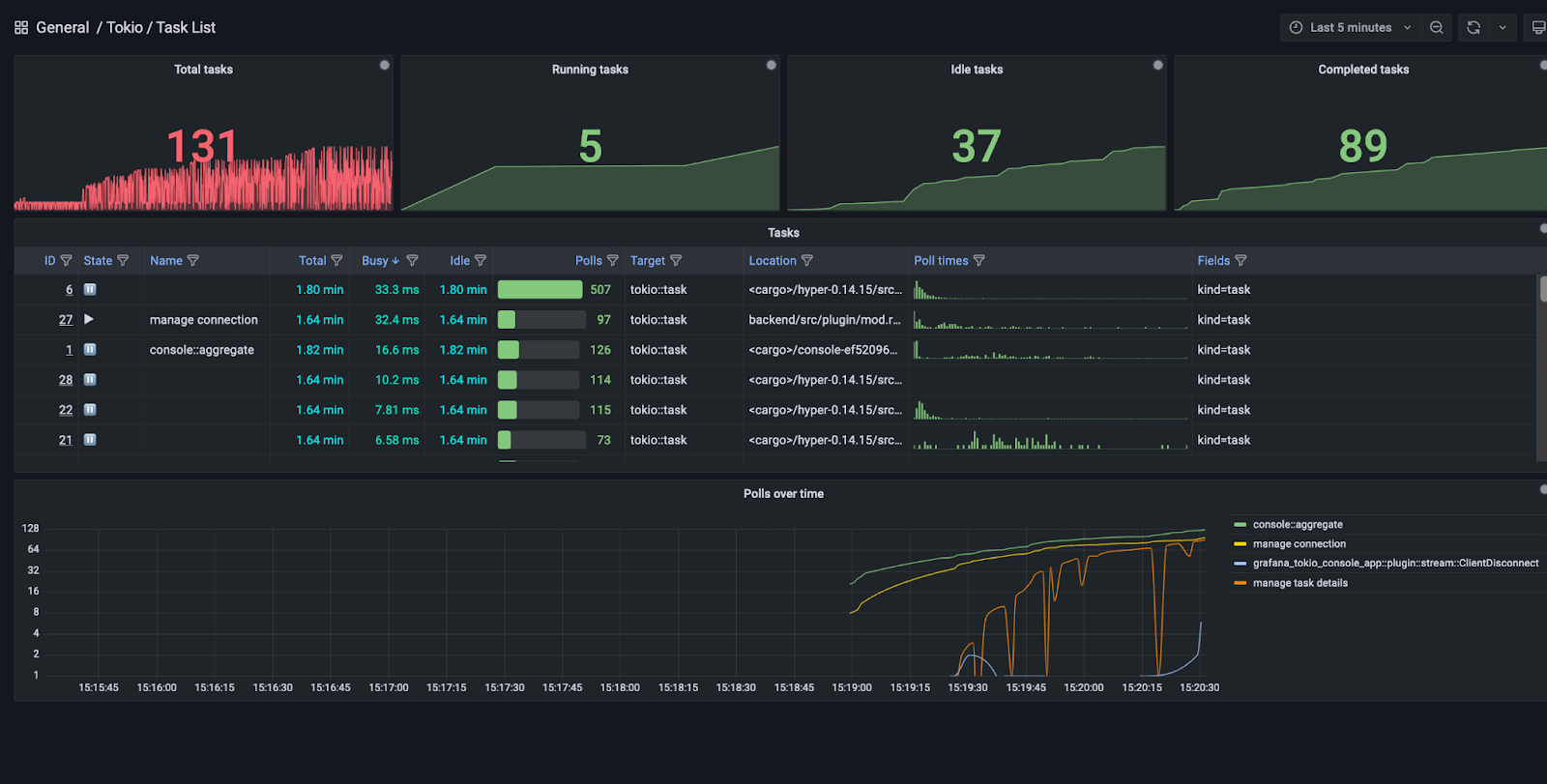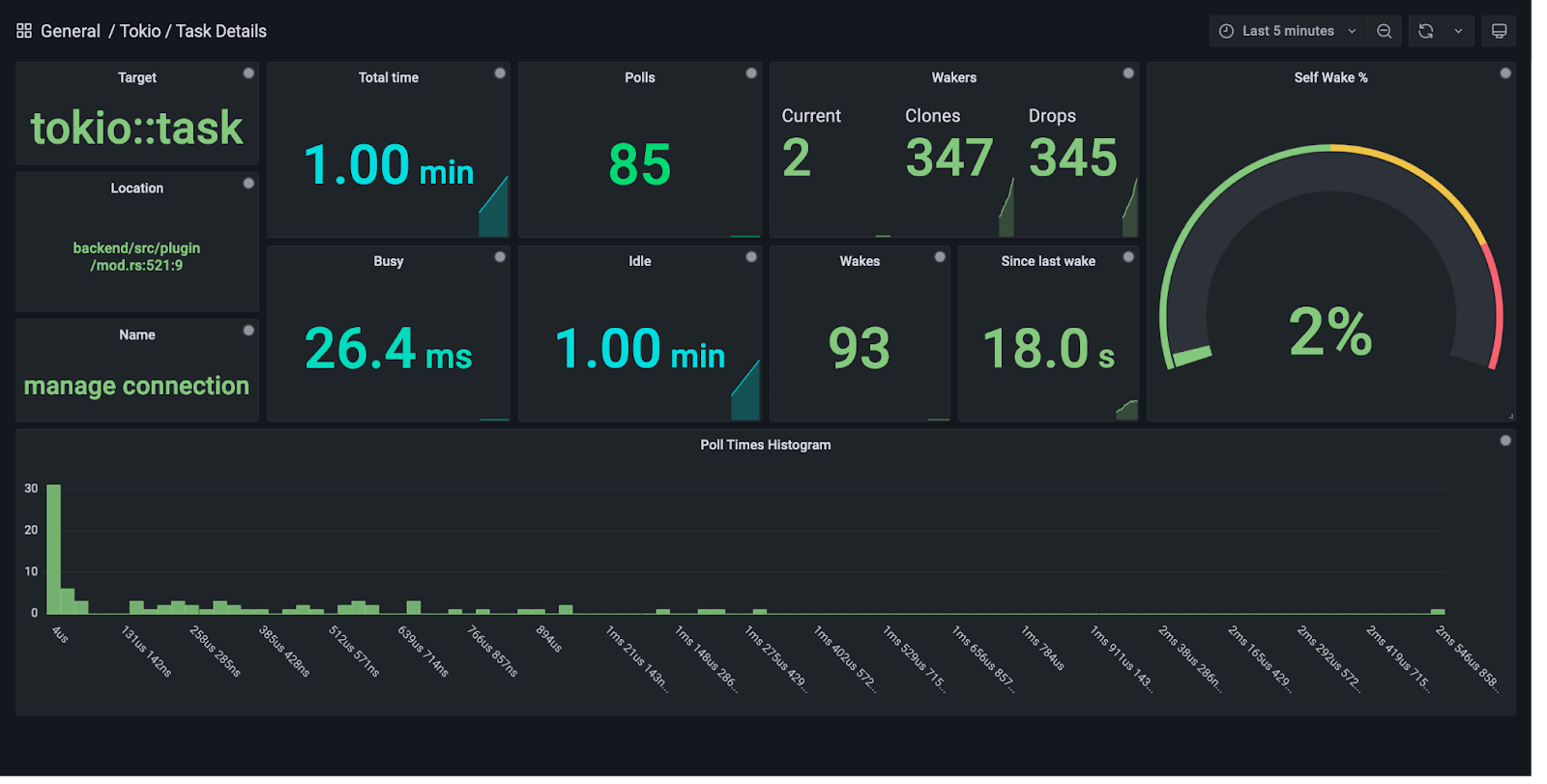https://github.com/sd2k/grafana-tokio-console-datasource
Tokio Console Datasource for Grafana
https://github.com/sd2k/grafana-tokio-console-datasource
grafana-plugin hacktoberfest rust tokio
Last synced: 2 months ago
JSON representation
Tokio Console Datasource for Grafana
- Host: GitHub
- URL: https://github.com/sd2k/grafana-tokio-console-datasource
- Owner: sd2k
- License: apache-2.0
- Created: 2021-12-02T14:28:41.000Z (about 4 years ago)
- Default Branch: main
- Last Pushed: 2023-02-06T08:50:26.000Z (almost 3 years ago)
- Last Synced: 2025-10-14T15:13:43.084Z (2 months ago)
- Topics: grafana-plugin, hacktoberfest, rust, tokio
- Language: Rust
- Homepage:
- Size: 1.35 MB
- Stars: 135
- Watchers: 67
- Forks: 4
- Open Issues: 5
-
Metadata Files:
- Readme: README.md
- Changelog: CHANGELOG.md
- License: LICENSE
Awesome Lists containing this project
README
# Grafana Tokio Console Data Source
This is a streaming Grafana data source which can connect to the Tokio [`console`] subscriber. It provides similar functionality to the `console` [TUI frontend][console-frontend] (albeit more limited at the moment!).
## Screenshots


## Try it out
### Docker
# On Linux or MacOS
docker run --rm -p 3000:3000 sd2k/grafana:with-tokio-console-datasource
# Or, on Linux, if you want to access console-enabled processes running on the host
docker run --rm --net=host sd2k/grafana:with-tokio-console-datasource
This will start a custom-built Grafana build serving on port 3000 with the Console datasource already installed.
Three datasources will already be configured:
- **Tokio Console - Grafana plugin** - connects to the console-enabled Grafana plugin backend itself, as an example. Note that the plugin serves on `localhost:6668`.
- **Tokio Console - localhost:6669** - connects to a console-enabled process at `localhost:6669`, the default address
- **Tokio Console - host.docker.internal:6669** - connects to a console-enabled process at `host.docker.internal:6669`. On MacOS (and possibly Windows - untested) this lets the Grafana process running inside Docker communicate with processes running _outside_ Docker using the special `host.docker.internal` address.
### Installing the plugin on an existing Grafana instance
The plugin is available on the [Grafana plugin marketplace](https://grafana.com/grafana/plugins/) so can be installed from there similarly to any other plugin.
## Development
### Plugin frontend
At the repository root:
1. Install dependencies
```bash
yarn install
```
2. Build plugin in development mode or run in watch mode
```bash
yarn dev
```
or
```bash
yarn watch
```
3. Build plugin in production mode
```bash
yarn build
```
### Plugin backend
Make sure you have a recent version of Rust (run `rustup update stable`), and install [`cargo-watch`].
Then run:
```bash
cargo xtask watch
```
This will run the `watch` task using the [`cargo-xtask`] pattern, which rebuilds the backend component on changes, copies the binary into the correct location, and restarts the plugin process (which Grafana subsequently restarts).
### Running Grafana
You'll need to clone a fork Grafana and run a specific branch to get some nice extra things working (namely the poll time histograms inside the main task list table):
1. Clone Grafana
```bash
git clone git@github.com/sd2k/grafana
```
2. Check out the custom branch
```bash
git checkout table-charts
```
3. Build the frontend
```bash
yarn && yarn dev
```
or, to watch for changes
```bash
yarn && yarn watch
```
4. Change some config - make sure to change the 'plugins' path to the parent directory of this
repo.
```bash
cat < conf/custom.ini
app_mode = development
[log]
level = debug
[paths]
plugins = /Users/ben/repos/grafana-plugins # or wherever you cloned this repo
[plugins]
plugin_admin_enabled = true
```
5. Run the Grafana backend
```bash
make run
```
6. Add a Tokio Console datasource
In your browser, navigate to http://localhost:3000/datasources/new, find the 'Tokio Console' datasource, and add a new instance Using the placeholder value of http://127.0.0.1:6669 should work; this datasource instance will connect to the plugin backend process itself, which is serving the console subscriber service.
You can then head to the datasource's Dashboards tab and import the provided dashboards.
## Cross compiling
### From MacOS
1. Install the relevant cross compiler toolchains. Using Homebrew:
```bash
brew tap messense/macos-cross-toolchains
brew install armv7-unknown-linux-musleabihf
brew install aarch64-unknown-linux-musl
brew install x86_64-unknown-linux-musl
brew install mingw-w64
```
2. Install the relevant Rust targets. Using `rustup`:
```bash
rustup target add armv7-unknown-linux-musleabihf
rustup target add aarch64-apple-darwin
rustup target add x86_64-apple-darwin
rustup target add aarch64-unknown-linux-musl
rustup target add x86_64-unknown-linux-musl
rustup target add x86_64-pc-windows-gnu
```
3. Run the following to compile the plugin in release mode for each target:
```bash
CARGO_TARGET_ARMV7_UNKNOWN_LINUX_MUSLEABIHF_LINKER=armv7-unknown-linux-musleabihf-ld cargo build --release --target armv7-unknown-linux-musleabihf
cargo build --release --target aarch64-apple-darwin
cargo build --release --target x86_64-apple-darwin
CARGO_TARGET_AARCH64_UNKNOWN_LINUX_GNU_LINKER=aarch64-unknown-linux-gnu-gcc cargo build --release --target aarch64-unknown-linux-gnu
CARGO_TARGET_AARCH64_UNKNOWN_LINUX_MUSL_LINKER=aarch64-unknown-linux-musl-gcc cargo build --release --target aarch64-unknown-linux-musl
CARGO_TARGET_X86_64_PC_WINDOWS_GNU_LINKER=x86_64-w64-mingw32-gcc cargo build --release --target x86_64-pc-windows-gnu
```
[`console`]: https://github.com/tokio-rs/console
[console-frontend]: https://github.com/tokio-rs/console#extremely-cool-and-amazing-screenshots
[`cargo-xtask`]: https://github.com/matklad/cargo-xtask
[`cargo-watch`]: https://github.com/watchexec/cargo-watch/